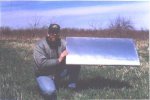KDOG
Gold Member
I was think of constructing a tail from aluminum tubing and aluminum sheet for the skin. What thickness for the skin do they normally use for such parts? Also I was thinking of using 1" tubing for the framework, .190 thickness - agree?
Barry K. was going to take some pictures and write out the specs for his tube and fabric tail, but I haven't heard anything and don't want to bug him so I'll use the extra time to investigate the other options!
Barry K. was going to take some pictures and write out the specs for his tube and fabric tail, but I haven't heard anything and don't want to bug him so I'll use the extra time to investigate the other options!

